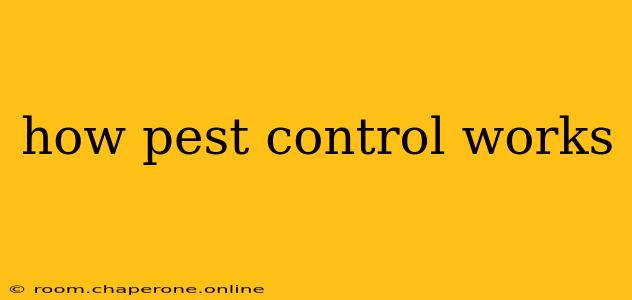Pest control is more than just spraying chemicals; it's a multi-faceted approach designed to eliminate pests and prevent their return. Understanding how pest control works involves recognizing the various methods employed, their effectiveness, and the importance of integrated pest management (IPM). This guide delves into the science and strategies behind effective pest management, helping you make informed decisions for your home or business.
Understanding Pest Behavior: The Foundation of Effective Control
Before tackling any pest problem, understanding the pest's behavior is crucial. This includes:
- Identification: Knowing the specific pest (e.g., ants, termites, rodents) allows for targeted treatment. Different pests have different habits, breeding cycles, and vulnerabilities.
- Life Cycle: Understanding the pest's life cycle – egg, larva, pupa, adult – helps determine the most effective control strategy. Targeting specific life stages can significantly reduce populations.
- Habitat and Food Sources: Identifying where pests live and what they eat is key to eliminating their access to resources. This may involve sealing entry points, removing attractants, and altering environmental conditions.
Key Methods in Pest Control: A Multi-pronged Approach
Pest control utilizes a range of methods, often in combination, for optimal results. These include:
1. Chemical Control: Targeted and Safe Application
While often the first thing that comes to mind, chemical control should be a considered part of a larger strategy, not the only one. Modern pest control utilizes targeted, low-impact chemicals that are effective against specific pests while minimizing environmental risks. Responsible applicators understand the importance of:
- Proper Identification: Selecting the right pesticide for the target pest is crucial for effectiveness and safety.
- Precise Application: Minimizing exposure to humans, pets, and the environment is paramount. This includes using appropriate equipment and techniques.
- Safety Precautions: Following label instructions meticulously is essential to avoid health risks and environmental damage.
2. Physical Control: Barriers, Traps, and Exclusion
Physical control methods focus on preventing pest access or directly removing them. These include:
- Exclusion: Sealing cracks and crevices in walls, foundations, and around pipes prevents pest entry.
- Traps: Glue traps, snap traps, and other trapping devices effectively capture and remove pests.
- Barriers: Physical barriers like screens, mesh, and netting can prevent pests from accessing certain areas.
3. Biological Control: Utilizing Natural Predators
Biological control involves introducing natural predators or pathogens to control pest populations. This eco-friendly approach can be highly effective and long-lasting. Examples include:
- Introducing Beneficial Insects: Ladybugs, lacewings, and other beneficial insects can prey on common garden pests.
- Parasitic Wasps: Some wasp species parasitize insect pests, reducing their populations naturally.
- Nematodes: Microscopic worms that attack and kill certain insect pests in the soil.
4. Cultural Control: Environmental Modifications
Modifying the environment to make it less hospitable to pests is a crucial aspect of IPM. This includes:
- Sanitation: Regular cleaning and removing clutter eliminates food sources and breeding sites.
- Proper Storage: Storing food in airtight containers prevents pest access.
- Moisture Control: Reducing moisture levels in the home or building can discourage pest infestations.
- Landscaping: Maintaining a well-maintained lawn and garden can reduce pest attraction.
Integrated Pest Management (IPM): A Holistic Approach
Integrated Pest Management (IPM) is a comprehensive approach that combines various control methods to achieve long-term pest management while minimizing environmental impact. It emphasizes:
- Monitoring: Regularly checking for pest activity to identify infestations early.
- Prevention: Implementing preventative measures to reduce pest attraction and entry.
- Targeted Control: Using the least toxic methods first, escalating to stronger interventions only when necessary.
- Evaluation: Assessing the effectiveness of control measures and adjusting the strategy as needed.
Conclusion: A Sustainable Approach to Pest Control
Effective pest control is a dynamic process that requires understanding pest behavior, utilizing a range of methods, and embracing a holistic approach like IPM. By combining chemical, physical, biological, and cultural controls, we can achieve sustainable pest management solutions that protect our health, our environment, and our property. Remember, consulting a professional pest control service can provide expert advice and tailored solutions for your specific needs.

